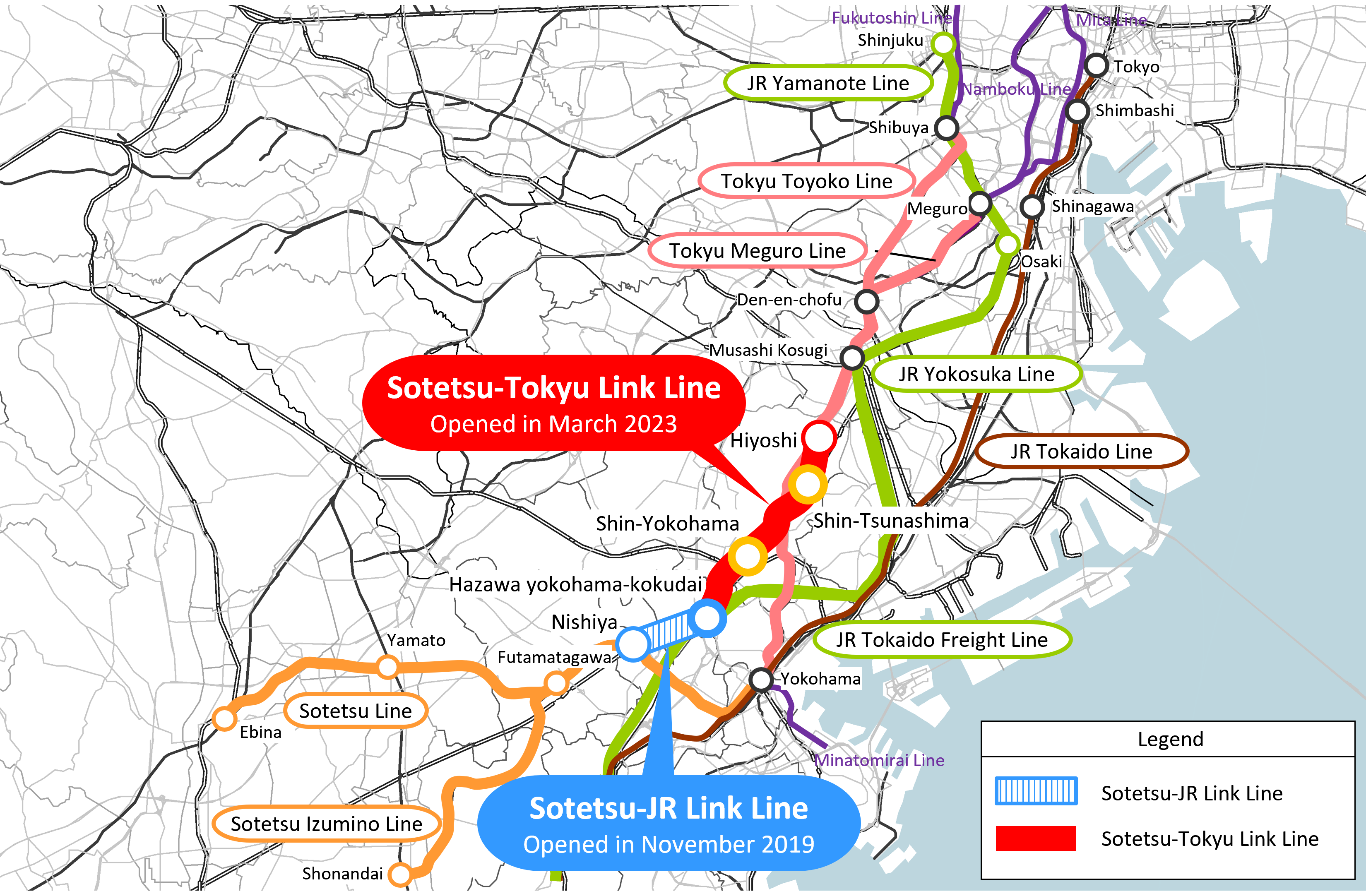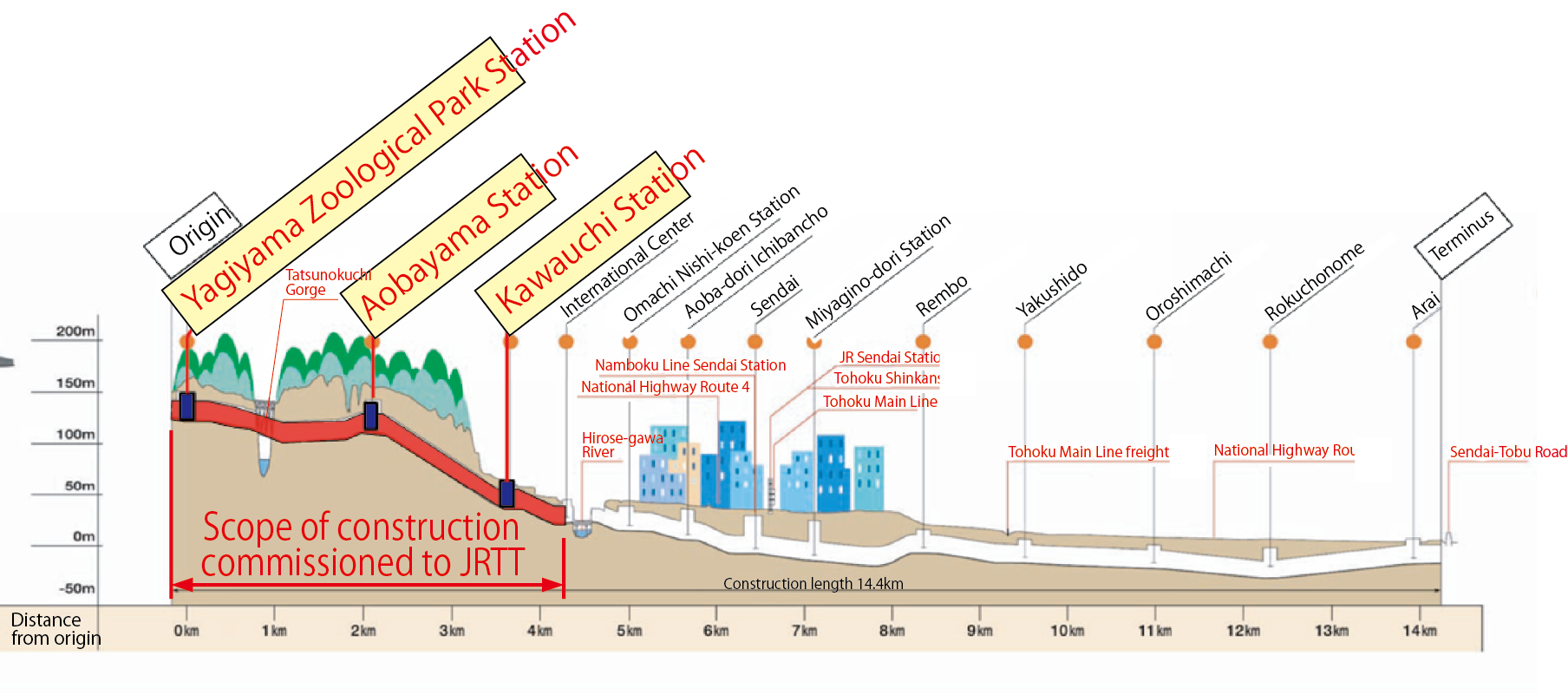Construction of Urban Railways
Urban Railways
Eastern Kanagawa Rail Link
(Sotetsu-JR Link Line / Sotetsu-Tokyu Link Line)
Outline

The Sotetsu-JR link line project is to construct a 2.7km of connecting line from Nishiya of Sotetsu line and Yokohama Hazawa of JR East's Tokaido freight line. The link line enables to operate through service between through the two lines. The Sotetsu-Tokyu link line project is to construct a 10km of connecting line from Yokohama Hazawa of JR East's Tokaido freight line and Hiyoshi of Tokyu line.
Passengers on the Sotetsu line for Tokyo once used to transfer at Yokohama to other Tokyo-bound lines such as JR East and Tokyu. Thanks to the new links, Sotetsu train can directly go onto Tokyo-bound lines without transfer and thus mobility of the people along the Sotetsu line is drastically improved. Another feature of the Sotetsu-Tokyu link line is 'connection to Shin-Yokohama station' which is a major gateway for the city of Yokohama on the Tokaido Shinkansen.
This project is based on "the Act on Enhancement of Convenience of Urban Railways, etc. " The aim of this project is to increase the convenience of the targeted railway lines. In this development scheme, rail infrastructure is constructed and owned by public entity, while trains are operated by railway companies.
Overview
| Construction area |
Nishiya station of Sotetsu line to Yokohama Hazawa station of JR East's Tokaido freight line |
| Operating area |
Ebina, Shonandai - Nishiya - Hazawa Yokohama-Kokudai - Shinjuku of JR East |
| Construction length | 2.7km |
| Builder | JRTT |
| Operator | Sagami Railway Co., Ltd. |
|
Frequency of train operation (one way) |
Morning rush hour: 4 services/hour Other: 2 - 3 services/hour |
| Construction area |
Yokohama Hazawa of JR East's freight line |
| Operating area |
Ebina, Shonandai of Sotetsu line - Nishiya - Hazawa Yokohama-Kokudai - Hiyoshi of Tokyu line - Shibuya and Meguro |
| Construction length | 10.0km |
| Builder | JRTT |
| Operator |
Sagami Railway Co., Ltd. and Tokyu Railways Co., Ltd. |
|
Frequency of train operation (one way) |
Morning rush hour: 10 - 14 services/hour Other: 4 - 6 services/hour |
Benefits by the new lines
Connection from western Yokohama and central Kanagawa to Tokyo will be convenient.
The opening of the Eastern Kanagawa Rail Link makes closer from western Yokohama and central Kanagawa to Shin-Yokohama station and Tokyo.
Reduction of the number of transfers
Direct connection to Tokyo reduces the number of transfers at intermediate stations, thus enables more comfortable and more convenient travel.

Access to Shinkansen will be improved
Access to Shin-Yokohama station on the Tokaido Shinkansen will be significantly improved.

A wide area railway network will be formed
Formation of a new railway network strengthens and stimulates regional cooperation and contributes to further development of areas along the lines.
Gallery
- Rail Joint Ceremony, Sotetsu-Tokyu link line (YouTube) *Japanese
- Construction site of Sotetsu-Tokyu link line 【second part】 (YouTube) *Japanese
- Construction site of Sotetsu-Tokyu link line (YouTube) *Japanese
- Test run of Sotetsu-JR Link Line (YouTube) *Japanese
- Development of Sotetsu-JR & Sotetsu-Tokyu link line (YouTube) *Japanese
Construction of Elevated Echizen Railway
The Fukui prefecture had planned to elevate three lines of Echizen Railway as a part of a project to create consecutive grade-separating viaducts in the vicinity of Fukui Station.
In September 2013, Echizen Railway Company asked JRTT to perform the elevation construction, which involves rerouting the original ground-level line (in yellow) to a temporary line on the future Hokuriku Shinkansen Viaduct (in blue), and then building viaducts for the new line (in red) over the original line.
The temporary line on the future Shinkansen viaducts started operation in September 2015. The new line was completed and opened in 2018.


Track construction of Fukui Station
Tsukuba Express Line
The Tsukuba Express Line is a 58-km railway that travels up to 130 km/h to connect Akihabara to Tsukuba Science City in 45 minutes. Since its opening on August 24, 2005, the line has provided a highly convenient, improved transportation system and commuters' comfort into the northeastern part of the capital by easing congestion of existing transportations.
Thanks to this line, high quality of convenience and promptness spur the provision of housing and large shopping malls along the line, thus produced a 120% increase in the number of passengers in the line's first 11 years since opening.
Tackling to increasing congestion of this line, in March 2013, the Metropolitan Intercity Railway Company commissioned JRTT to construct additional track to a spur line from Moriya Station to a rolling stock depot. The original spur line was a single track, and the second line was added to extend functions of the rolling stock depot. We completed the construction and the new line went into service in March 2017.


Sendai Subway Tozai Line
The Sendai Subway Tozai Line is 14.4km long municipal subway which connects Zoological Park Area in the southwestern part and expressway interchange area in the eastern part in the city of Sendai.
Completion of The Tozai Line (which means 'east and west') makes up a fundamental transportation network of the city with previously constructed subway Namboku Line (which means 'north and south'). JRTT constructed 4.3km long western segment of the line. Notable civil structures of the line are, Station Tunnel with large cross section excavated by NATM (Sequential Excavation Method), the Tatsunokuchi Double Deck Truss Bridge which contains railway and road, and 57‰ steep section at the western end of the line whose elevation difference reaches 110m.
Train sets are propelled by the linear motor system which makes it available to climb the steep gradient and downsize the cross section of tunnels and reduce the total cost.

Narita Sky Access Line
The Narita Sky Access Line is an airport access railway that connects Narita Airport, the main gateway to Japan and to central Tokyo. The 51.4-km line opened on July 17, 2010. Trains operate at a maximum speed of 130 km/h in the 32.3-km section between Keisei-Takasago Station and Imba-Nihon-Idai Station on the upgraded Hokuso Line, and a maximum speed of 160 km/h in the newly constructed 10.7-km section between Imba-Nihon-Idai and Tsuchiya as well as the 8.4-km section between Tsuchiya and Narita Airport on the Narita Airport Rapid Railway Line.
Compared to the former access by Keisei Main Line which was the original route, the new line trims 15 minutes from the travel time between central Tokyo and Narita Airport. The new line has also improved convenience for residents of northwestern Chiba Prefecture and contributed to the linking and enhancement of functions of the city of Narita and the Chiba New Town development.


Reconstruction of Railways after the Great East Japan Earthquake
Sanriku Railway 'Rias line' was originally planned as a National Railway line along the Sanriku Rias Coast in 1960s. Though some sections were completed by JRCC (Japan Railway Construction Public Corporation, former entity of JRTT), construction of other parts was once abandoned due to the privatization of National Railways.
To revive the whole plan of the line, local municipalities along the line were cooperatively established half-governmental 'Sanriku Railway Company' in 1981. The company commissioned JRCC again to construct the other parts and opened 'Kita-Rias line' and 'Minami-Rias line' in 1985. (Intervening section had been previously operated by National Railways and was transferred to successor JR East.)
In 2011, enormous tsunami waves generated by the Great East Japan Earthquake devastated the Sanriku Railway lines.
On November 1, 2011, Sanriku Railway commissioned JRTT to reconstruct the railway. This works mainly consisted of recovering embankments, tracks and communication cables swept away by the tsunami waves, rebuilding stations and bridges, and repairing bridges damaged by the earthquake. Operation on the lines resumed in some phases until the lines were fully reopened in 2014.


